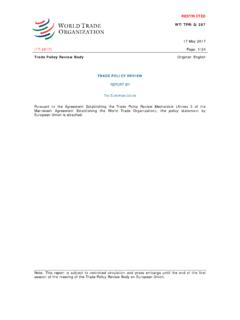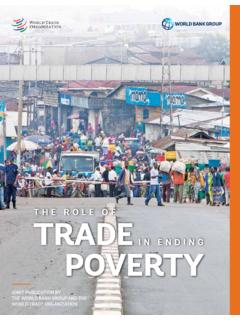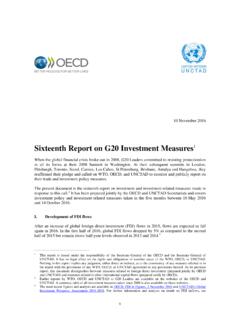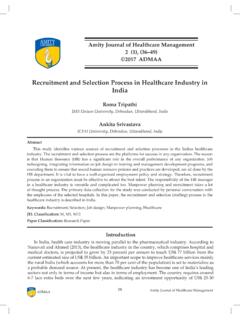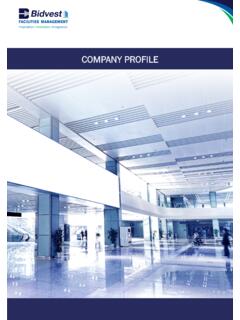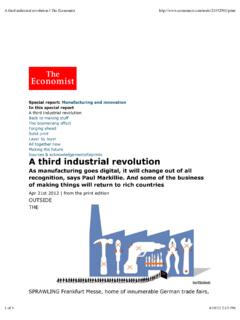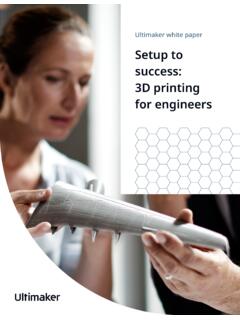Transcription of The Global Textile and Clothing Industry post the …
1 DISCUSSION PAPER NO 5 The Global Textile and Clothing Industry post the Agreement on textiles and Clothing by Hildegunn Kyvik Nord s1 World Trade Organization Geneva, Switzerland Disclaimer and citation guideline Discussion Papers are presented by the authors in their personal capacity and opinions expressed in these papers should be attributed to the authors. They are not meant to represent the positions or opinions of the WTO Secretariat or of its Members and are without prejudice to Members' rights and obligations under the WTO. Any errors or omissions are the responsibility of the authors.
2 Any citation of this paper should ascribe authorship to staff of the WTO Secretariat and not to the WTO. 1 Research assistance from Roberto Chavez and useful comments from Michael Finger and Robert Teh are gratefully acknowledged. This paper is only available in English Price CHF To order, please contact: WTO Publications Centre William Rappard 154 rue de Lausanne CH-1211 Geneva Switzerland Tel: (41 22) 739 52 08 Fax: (41 22) 739 57 92 Website: E-mail: ISSN 1726-9466 ISBN 92-870-1244-X Printed by the WTO Secretariat VII-2004, 1,000 World Trade Organization, 2004.
3 Reproduction of material contained in this document may be made only with written permission of the WTO Publications Manager. With written permission of the WTO Publications Manager, reproduction and use of the material contained in this document for non-commercial educational and training purposes is encouraged..TABLE OF CONTENTS I. INTRODUCTION ..1 II. THE STRUCTURE OF THE Textile AND Clothing SECTOR ..3 III. THE AGREEMENT ON textiles AND Clothing ..13 IV. TRADE PATTERNS IN textiles AND Clothing ..16 V. THE IMPACT OF PHASING OUT THE VI. VII. REFERENCES ..35 LIST OF TABLES AND CHARTS FIGURE 1: THE SUPPLY CHAIN IN THE Textile AND Clothing FIGURE 2: VERTICAL SPECIALIZATION SHARE IN EXPORTS, SELECTED COUNTRIES AND TERRITORIES, 2001.
4 9 FIGURE 3: SOURCE OF IMPORTS OF textiles TO THE FIGURE 4: SOURCE OF IMPORTS OF Clothing TO FIGURE 5: SOURCES OF IMPORTS OF textiles TO THE EU ..20 FIGURE 6: SOURCES OF IMPORTS OF Clothing TO EU ..21 FIGURE 7: MARKET SHARES BEFORE AND AFTER QUOTA ELIMINATION, textiles , FIGURE 8: MARKET SHARES BEFORE AND AFTER QUOTA ELIMINATION, Clothing , EU ..28 FIGURE 9: MARKET SHARES BEFORE AND AFTER QUOTA ELIMINATION, textiles , FIGURE 10: MARKET SHARES BEFORE AND AFTER QUOTA ELIMINATION, Clothing , USA .. 30 TABLE 1: THE COST STRUCTURE OF THE Clothing Industry , SELECTED COUNTRIES, 2001 (PER CENT OF GROSS OUTPUT).
5 7 TABLE 2: THE COST STRUCTURE OF THE Textile Industry , SELECTED COUNTRIES, 2001 (PER CENT OF GROSS OUTPUT) ..8 TABLE 3: EMPLOYMENT IN textiles AND Clothing , ATC COUNTRIES (THOUSANDS)..10 TABLE 4: EMPLOYMENT IN Textile AND Clothing (THOUSANDS) ..12 TABLE 5: INTEGRATION OF textiles AND Clothing INTO TABLE 6: INTEGRATION DURING THE FIRST 3 STAGES ..14 TABLE 7: THE US TRADING PARTNERS' TRADE WITH THE UNITED STATES, 2002 ..19 TABLE 8: EU'S TRADING PARTNERS' TRADE WITH EU, 2002 ..22 TABLE 9: CHINA'S SHARE OF TOTAL IMPORTS, SELECTED COUNTRIES ..23 TABLE 10: EXPORT TAX EQUIVALENT OF QUOTAS BASE YEAR.
6 25 TABLE 11: IMPORTS AS SHARE OF DOMESTIC DEMAND WITH AND WITHOUT QUOTAS ..26 TABLE 12: REVEALED COMPARATIVE ADVANTAGE AND BINDING QUOTAS, 2000..32 1 I. INTRODUCTION After more than forty years of import quotas, the Textile and Clothing sector will become subject to the general rules of the General Agreement on Tariffs and Trade from 1 January, 2005. Liberalization has been controversial because both textiles and Clothing contribute to employment in developed countries, particularly in regions where alternative jobs may be difficult to find.
7 In the European Union, for example, the sector is dominated by small and medium-sized enterprises concentrated in a number of regions that are highly dependent on this sector (Commission of the European Communities, 2003). textiles and Clothing are also among the sectors where developing countries have the most to gain from multilateral trade liberalization. In fact, the prospect of liberalization of the textiles and Clothing sectors was one of the reasons why developing countries accepted to include services and intellectual property rights areas to which they were sceptical at the outset in the Uruguay Round (Reinert, 2000).
8 The objective of this paper is to assess the likely impact of liberalization, taking into account recent technological and managerial developments in the sector, and focusing on recent developments in supply chain management in the Clothing and textiles sectors. The Clothing Industry is labour-intensive and it offers entry-level jobs for unskilled labour in developed as well as developing countries. Job creation in the sector has been particularly strong for women in poor countries, who previously had no income opportunities other than the household or the informal Moreover, it is a sector where relatively modern technology can be adopted even in poor countries at relatively low investment costs.
9 These technological features of the Industry have made it suitable as the first rung on the industrialization ladder in poor countries, some of which have experienced a very high output growth rate in the sector ( Bangladesh, Sri Lanka, Viet Nam and Mauritius).3 These characteristics, however, have also made it a footloose Industry 2 See Nord s (2003a) for a discussion. 3 The Textile and Clothing sector has also grown very fast in more developed countries that have entered into preferential agreements with the EU or the US or both ( Bulgaria, Lithuania, Macedonia and Jordan).
10 That is able to adjust to changing market conditions quickly. At the same time, the Textile and Clothing Industry has high-value added segments where design, research and development (R&D) are important competitive factors. The high end of the fashion Industry uses human capital intensively in design and marketing. The same applies to market segments such as sportswear where both design and material technology are important. Finally, R&D is important in industrial textiles where, again, material technology is an important competitive factor.




